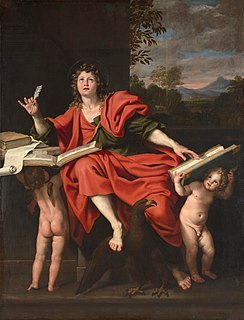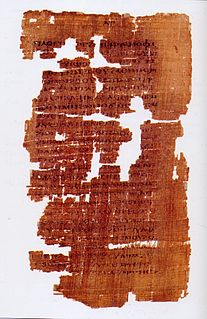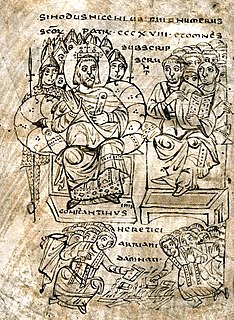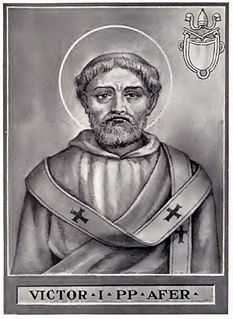In the Platonic, Neopythagorean, Middle Platonic, and Neoplatonic schools of philosophy, the demiurge is an artisan-like figure responsible for fashioning and maintaining the physical universe. The Gnostics adopted the term "demiurge". Although a fashioner, the demiurge is not necessarily the same as the creator figure in the monotheistic sense, because the demiurge itself and the material from which the demiurge fashions the universe are both considered to be consequences of something else. Depending on the system, they may be considered to be either uncreated and eternal or the product of some other entity.

Irenaeus was a Greek cleric noted for his role in guiding and expanding Christian communities in what is now the south of France and, more widely, for the development of Christian theology by combatting heresy and defining orthodoxy. Originating from Smyrna, now Izmir in Turkey, he had heard the preaching of Polycarp, who in turn was said to have heard John the Evangelist.

Polycarp was a 2nd-century Christian bishop of Smyrna. According to the Martyrdom of Polycarp he died a martyr, bound and burned at the stake, then stabbed when the fire failed to touch him. Polycarp is regarded as a saint and Church Father in the Eastern Orthodox, Oriental Orthodox, Catholic, Anglican, and Lutheran churches. His name 'Polycarp' means 'much fruit' in Greek.

Marcion of Sinope was an important figure in early Christianity. His theology rejected the deity described in the Hebrew Scriptures and in distinction affirmed the Father of Christ as the true God. The Church Fathers denounced Marcion, and he was excommunicated from the proto-orthodox Church. He published his own list of New Testament books, making him a catalyst in the process of the development of the New Testament canon by forcing the early Church to respond to his claims.
Marcionism was an Early Christian dualist belief system that originated in the teachings of Marcion of Sinope at Rome around the year 144.
Cerinthus was an early gnostic Christian, who was prominent as a heresiarch in the view of the early Church Fathers. Contrary to the Church Fathers, he used the Gospel of Cerinthus, and denied that the Supreme God made the physical world. In Cerinthus' interpretation, the Christ descended upon Jesus at baptism and guided him in ministry and the performing of miracles, but left him at the crucifixion. Similarly to the Ebionites, he maintained that Jesus was not born of a virgin, but was a mere man, the biological son of Mary and Joseph.

The authorship of the Johannine works—the Gospel of John, Epistles of John, and the Book of Revelation—has been debated by scholars since at least the 2nd century AD. The main debate centers on who authored the writings, and which of the writings, if any, can be ascribed to a common author.

The Gospel of Truth is one of the Gnostic texts from the New Testament apocrypha found in the Nag Hammadi codices ("NHC"). It exists in two Coptic translations, a Subakhmimic rendition surviving almost in full in the first codex and a Sahidic in fragments in the twelfth.
Valentinianism was one of the major Gnostic Christian movements. Founded by Valentinus in the second century AD, its influence spread widely, not just within Rome, but also from Northwest Africa to Egypt through to Asia Minor and Syria in the east.
In Christian Gnostic religious history, the Colarbasians were a supposed sect of the 2nd century, deemed heretics, so called from their leader Colarbasus, a disciple of Valentinius. Colarbasus, along with Marcus, another disciple of Valentinius, was said to maintain the whole plenitude, and perfection of truth and religion, to be contained in the Greek alphabet; and that it was for this reason that Jesus was called the Alpha and Omega.
Marcus was the founder of the Marcosian Gnostic sect in the 2nd century AD. He was a disciple of Valentinus, with whom his system mainly agrees. His doctrines are almost exclusively known to us through a long polemic in Adversus Haereses, in which Irenaeus gives an account of his teaching and his school. Clement of Alexandria clearly knew of Marcus and actually used his number system, though without acknowledgement.

Christianity in the 2nd century was largely the time of the development of variant Christian teachings, and the Apostolic Fathers who are regarded as defenders of the developing proto-orthodoxy. Major figures who were later declared by the developing proto-orthodoxy to be heretics were Marcion, Valentinius, and Montanus.

The canon of the New Testament is the set of books Christians regard as divinely inspired and constituting the New Testament of the Christian Bible. For most, it is an agreed-upon list of twenty-seven books that includes the Canonical Gospels, Acts, letters of the Apostles, and Revelation. The books of the canon of the New Testament were written before 120 AD.

Traditionally in Christianity, orthodoxy and heresy have been viewed in relation to the "orthodoxy" as an authentic lineage of tradition. Other forms of Christianity were viewed as deviant streams of thought and therefore "heterodox", or heretical. This view was challenged by the publication of Walter Bauer's Rechtgläubigkeit und Ketzerei im ältesten Christentum in 1934. Bauer endeavored to rethink Early Christianity historically, independent from the views of the current church. He stated that the 2nd-century church was very diverse and included many "heretical" groups that had an equal claim to apostolic tradition. Bauer interpreted the struggle between the orthodox and heterodox to be the "mainstream" Church of Rome struggling to attain dominance. He presented Edessa and Egypt as places where the "orthodoxy" of Rome had little influence during the 2nd century. As he saw it, the theological thought of the "Orient" at the time would later be labeled "heresy". The response by modern scholars has been mixed. Some scholars clearly support Bauer's conclusions and others express concerns about his "attacking [of] orthodox sources with inquisitional zeal and exploiting to a nearly absurd extent the argument from silence." However, modern scholars have critiqued and updated Bauer's model.
In many Gnostic systems, various emanations of "God" are known by such names as One, Monad, Aion teleos, Bythos, Proarkhe, Arkhe, and Aeons. In different systems these emanations are differently named, classified, and described, but emanation theory is common to all forms of Gnosticism. In Basilidian Gnosis they are called sonships ; according to Marcus, they are numbers and sounds; in Valentinianism they form male/female pairs called syzygies.
Marcellina was an early Christian Carpocratian religious leader in the mid-second century AD known primarily from the writings of Irenaeus and Origen. She originated in Alexandria, but moved to Rome during the episcopate of Anicetus. She attracted large numbers of followers and founded the Carpocratian sect of Marcellians. Like other Carpocratians, Marcellina and her followers believed in antinomianism, also known as libertinism, the idea that obedience to laws and regulations is unnecessary in order to attain salvation. They believed that Jesus was only a man, but saw him as a model to be emulated, albeit one which a believer was capable of surpassing. Marcellina's community appears to have sought to literally implement the foundational Carpocratian teaching of social egalitarianism. The Marcellians in particular are reported to have branded their disciples on the insides of their right earlobes and venerated images of Jesus as well as Greek philosophers such as Pythagoras, Plato, and Aristotle. Although the Marcellians identified themselves as "gnostics", many modern scholars do not classify them as members of the sect of Gnosticism.
Adversus Valentinianos, or Against the Valentinians, is a famous refutation of Valentinianism by Tertullian, an orthodox contemporary of the Gnostics and one of the first to investigate them. The work satirized the bizarre elements that appear in Gnostic mythology, ridiculing the Gnostics for creating elaborate cosmologies, with multi-storied heavens like apartment houses.











